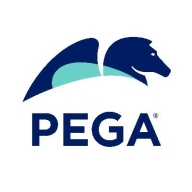

Pega Platform and ServiceNow Now Platform compete in automation and service management solutions. Pega seems to have the upper hand in case management and integration, offering rapid prototyping and comprehensive solutions catering to enterprise needs.
Features: Pega Platform includes rapid prototyping, case management, and a no-code environment, significantly aiding users seeking extensive integration and customization. ServiceNow excels in IT service management, featuring robust workflows and automation capabilities, favored for incident management and ticketing.
Room for Improvement: Pega Platform needs RPA enhancements, integration options, and improved UI features. Machine learning functionalities and more business-ready solutions are also areas for growth. ServiceNow faces challenges with high costs, limited customization in certain modules, and a complex licensing model, requiring more intuitive UI options and integration improvement.
Ease of Deployment and Customer Service: Pega Platform supports multiple deployment models like On-premises, Public, Private, and Hybrid Clouds, offering flexibility but potentially causing complex setups. ServiceNow typically uses a public cloud model, ensuring consistency. Both platforms have room for improved technical support response times, with ServiceNow potentially delaying complex issue resolutions.
Pricing and ROI: Pega Platform generally leans on the expensive side, more suited for larger enterprises, but offers good ROI through process streamlining. ServiceNow also presents high costs with licensing fees and potential additional expenses but provides valuable functionality and noticeable ROI, especially for enterprises requiring extensive service management solutions.
The technical support from Pega is very low, rating a one or two out of ten.
I never needed support from the platform standpoint, but if additional features are required, we have regular meetings with the product team for feedback.
Pega's technical support team is very helpful.
They have enough knowledge to say the right things.
Currently, big banking providers and insurance providers, even the members for healthcare payers, are using more than millions of operations on a daily or weekly basis.
Users can build and modify the platform according to their needs.
It is easily scalable and very powerful in this direction.
I haven't had any situations where it would be unavailable for our calls, so I don't have complaints there.
With the recent development of AI agents in Pega Platform 24.2, the adoption is not heavy due to regulations around using external LLM by customers, especially regulated customers in BFSS and healthcare.
Pega introduced Constellation, which allows a user to build a more engaging visual experience.
My learning curve in robotics has been challenging.
Historical data isn't as easily available as expected and it requires buying additional licenses for more features.
It lacks support for rollbacks in case of complex customer processes.
The user interface could be modernized and made more attractive for users.
Pega is priced higher than open-source options like Flowable but is suitable for large-scale industries like banking and insurance.
The pricing is expensive, and this is an issue.
From a licensing perspective, it is higher than the competition.
ServiceNow Now Platform is an expensive product.
ServiceNow Now Platform falls within the more expensive tier of a product.
Pega Platform is excellent for enterprise-level solutions with integrations to entire systems, including case management, service orchestration, CRM, decision-making capabilities, digital process automation, and AI-driven functionalities.
Management capabilities such as dashboards.
It is extremely powerful and very much customizable, which allows for quick building of solutions around it.
The text-to-code feature is particularly useful for turning natural language instructions into recognizable code on the ServiceNow platform, aiding both implementation teams and customers.
The most valuable features are the ease of use, stability, and the ability to change or upgrade seamlessly.
| Product | Market Share (%) |
|---|---|
| Pega Platform | 6.7% |
| ServiceNow Now Platform | 1.9% |
| Other | 91.4% |


| Company Size | Count |
|---|---|
| Small Business | 9 |
| Midsize Enterprise | 15 |
| Large Enterprise | 68 |
| Company Size | Count |
|---|---|
| Small Business | 14 |
| Midsize Enterprise | 3 |
| Large Enterprise | 34 |
Pega Platform facilitates business process management, case management, and workflow automation for industries like banking, insurance, and healthcare. It supports digital transformation and customer service enhancements with its low-code capabilities and seamless integrations.
Pega Platform enables users to create efficient systems for case management, financial operations, and digital transformations. It provides tools for client onboarding, quoting, claims processing, customer experience improvements, and content management. Pega's low-code approach allows for the automation of complex processes, making it suitable for enterprises looking for adaptability and rapid deployment. While it offers strong real-time analytics and decision automation, users acknowledge challenges in user interface, integration, and performance aspects. High costs and a learning curve need attention, and enhancements in AI features and cloud services are desired.
What are the key features of Pega Platform?In banking, Pega Platform automates loan processing, accelerates customer onboarding, and manages compliance. Insurance companies benefit from streamlined claims processing and policy management. Healthcare sectors use the platform for patient engagement and care coordination, enabling organizations to adapt quickly to changing industry requirements.
ServiceNow Now Platform enhances IT service management with request cataloging, incident handling, and knowledge management. Its low-code environment, integration capability, and flexible workflow automation offer a smooth user experience and scalable solutions for enterprises.
ServiceNow Now Platform is designed for seamless integration across IT service management, including incident, problem, and change management. Known for stable performance and a user-friendly interface, it supports flexible workflow automation, efficient report generation, and comprehensive data management. The platform's scalability and low-code customization create opportunities for innovative process automation, enriching user experience. While its licensing and pricing models could be more user-friendly, enhancements in mobile capabilities, AI integration, and modern UI are on demand. Additional improvements in ERP integration and technical support are also needed. The platform serves multiple sectors with configurations for enhanced process automation and service orchestration.
Which features stand out?In diverse industries, ServiceNow Now Platform supports a variety of functions such as IT service management, customer support, workflow automation, and service delivery. Organizations employ it for HR processes, analytics, asset management, and compliance. Its strong integration capabilities allow it to be paired with existing tools, offering flexible configurations and end-user support on a global scale, making it suitable for companies across sectors.
We monitor all Rapid Application Development Software reviews to prevent fraudulent reviews and keep review quality high. We do not post reviews by company employees or direct competitors. We validate each review for authenticity via cross-reference with LinkedIn, and personal follow-up with the reviewer when necessary.